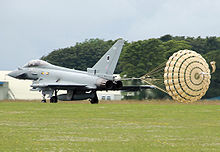Drogue parachute

A Boeing B-52 Stratofortress from the 307th Bomb Wing deploying its drag chute for landing
 Play media
Play mediaDrogue parachute deployed on a SAAF BAE Hawk

RAF Typhoon using a drag parachute for extra braking after landing

Aeroflot Tupolev Tu-104B at Arlanda Airport in 1968.
A drogue parachute is a parachute designed to be deployed from a rapidly moving object in order to slow the object, to provide control and stability, or as a pilot parachute to deploy a larger parachute. It was invented in Russia by Gleb Kotelnikov in 1912.
Contents
1 Design and operational characteristics
2 History
3 Use
3.1 Parachuting
3.2 Deceleration
3.3 Stability
4 See also
5 References
6 External links
Design and operational characteristics
A drogue parachute is more elongated and has a far smaller area than a conventional parachute and therefore provides less drag. This means that a drogue parachute cannot slow an object as much as a conventional parachute, but it can be deployed at speeds at which conventional parachutes would be torn apart.[1]
The drogue parachute's simpler design allows for easier deployment. Where a conventional parachute could get caught in itself while unfolding or fail to inflate properly (thus not slowing the falling object as much as it should), the drogue parachute will inflate more easily and more reliably to generate the expected amount of drag.
History
The drogue parachute was used for the first time in 1912 by Russian inventor Gleb Kotelnikov, who had introduced the knapsack parachute a year before. On a road near Tsarskoye Selo (now part of St. Petersburg), Kotelnikov successfully demonstrated the braking effects of such a parachute by accelerating a Russo-Balt automobile to its top speed and then opening a parachute attached to the back seat.[2]

The NASM's Arado Ar 234B German jet bomber's drogue chute installation.
Drogue chutes were first used in aviation in 1937 by the Soviet airplanes in the Arctic that were providing support for the famous polar expeditions of the era such as the first drifting ice stations North Pole-1, which was launched the same year. The drogue chute enabled airplanes to land safely on smaller ice-floes.[2]
One of the earliest regular production military aircraft to use a drogue chute to slow down and shorten the landing was the Arado Ar 234 reconnaissance-bomber of the Luftwaffe, as both the trolley-and-skid undercarriage series of eight prototypes for the never-produced Ar 234A series — one on the aircraft, and a separate system on the aft surface of the trolley's main axle — and the tricycle undercarriage-equipped Ar 234B production series were fitted with drogue chute deployment capability in the extreme rear ventral fuselage.
Use
Parachuting
Drogue parachutes are sometimes used to deploy a main or reserve parachute by using the drag generated by the drogue to pull the main parachute out of its container. Such a drogue is referred to as a pilot chute when used in a single user (sports) parachute system. The pilot chute is only used to deploy the main or reserve parachute; it is not used for slowing down or for stability. Tandem systems are different; a drogue is so deployed shortly after exiting the aircraft as to reduce the terminal velocity of the pair of tandem jumpers. It is later used to deploy the main parachute as on sports systems.
Deceleration

Dual braking parachutes fitted to jet dragsters. The parachutes are in the smaller tubes with yellow straps.
When used to shorten an aircraft's landing, a drogue chute is called a drag parachute or braking parachute.
Braking parachutes are also employed to slow drag racing (NHRA requires them on all vehicles that reach 150 miles per hour) and land speed record vehicles.[3]
Stability
Drogue parachutes may also be used to help stabilise direction of something in flight, such as a thrown RKG-3 anti-tank grenade.
It is often used to gain control of very fast descents, including those of spacecraft during atmospheric reentry or nuclear bombs such as the B61 and B83. Some escape capsules used by supersonic aircraft deploy drogue parachutes to stabilise and slow down, allowing either a main chute to be deployed or the pilot to exit the capsule and use a personal chute.
See also
- Air brake (aircraft)
- Drogue
References
^ "Abbreviations and Acronyms". Relive Apollo 11. NASA..mw-parser-output cite.citation{font-style:inherit}.mw-parser-output .citation q{quotes:"""""""'""'"}.mw-parser-output .citation .cs1-lock-free a{background:url("//upload.wikimedia.org/wikipedia/commons/thumb/6/65/Lock-green.svg/9px-Lock-green.svg.png")no-repeat;background-position:right .1em center}.mw-parser-output .citation .cs1-lock-limited a,.mw-parser-output .citation .cs1-lock-registration a{background:url("//upload.wikimedia.org/wikipedia/commons/thumb/d/d6/Lock-gray-alt-2.svg/9px-Lock-gray-alt-2.svg.png")no-repeat;background-position:right .1em center}.mw-parser-output .citation .cs1-lock-subscription a{background:url("//upload.wikimedia.org/wikipedia/commons/thumb/a/aa/Lock-red-alt-2.svg/9px-Lock-red-alt-2.svg.png")no-repeat;background-position:right .1em center}.mw-parser-output .cs1-subscription,.mw-parser-output .cs1-registration{color:#555}.mw-parser-output .cs1-subscription span,.mw-parser-output .cs1-registration span{border-bottom:1px dotted;cursor:help}.mw-parser-output .cs1-ws-icon a{background:url("//upload.wikimedia.org/wikipedia/commons/thumb/4/4c/Wikisource-logo.svg/12px-Wikisource-logo.svg.png")no-repeat;background-position:right .1em center}.mw-parser-output code.cs1-code{color:inherit;background:inherit;border:inherit;padding:inherit}.mw-parser-output .cs1-hidden-error{display:none;font-size:100%}.mw-parser-output .cs1-visible-error{font-size:100%}.mw-parser-output .cs1-maint{display:none;color:#33aa33;margin-left:0.3em}.mw-parser-output .cs1-subscription,.mw-parser-output .cs1-registration,.mw-parser-output .cs1-format{font-size:95%}.mw-parser-output .cs1-kern-left,.mw-parser-output .cs1-kern-wl-left{padding-left:0.2em}.mw-parser-output .cs1-kern-right,.mw-parser-output .cs1-kern-wl-right{padding-right:0.2em}
^ ab Parachuting at the site Divo: The Russian Book of records and achievements (in Russian)
^ "North American Eagle Project: Deceleration – High Speed Parachute Systems". Archived from the original on 2010-10-09.
External links
| Wikimedia Commons has media related to Drogue parachutes. |

Comments
Post a Comment